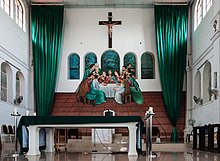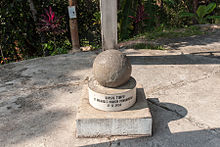St. Michael Church (Donggongon)
The St. Michael Church (German Saint Michael Church ) is a Catholic church in Donggongon in the Malaysian state of Sabah. It is the oldest church in the Penampang district and the second oldest stone church in Sabah.
description
The church is located on a steep hill in Donggongon, a small town in the Penampang district. The church is built in stone. The church also has a cemetery, a bell tower, a Marian grotto, the rectory and a parish hall .
history
The missionary work of Sabah is closely linked to the work of the Mill-Hill missionaries . Her activities in Penampang began in 1886 with the establishment of a mission station in Kampung Inobong by Fr. Prenger. Some time later the missionaries decided to set up a branch of the mission station on a hill in Kampung Dabak near Penampang. The location of the hill in the middle of the rice fields and close to the Sungai Moyog promised to reach more people on the one hand, and on the other hand the hill was considered a favorable place for the future building of a church. With the transfer of Fr. Rientje from Sandakan to Penampang, the branch office became an independent mission station in 1889. In the same year a first church building was built in Penampang.
Brother Rientjes drowned on May 15, 1891 in Sungai Putatan . His successor, Fr. Duxneuner, intensified the missionary work in Penampang so much that in 1905 the original mission station in Inobong was declared a branch of Penampang. In 1906, Duxneuner was assigned Fr. August Wachter as his assistant, but had to hand him over to Inobong in 1910 so that he could rebuild the former mission station there. Only in 1917 did Wachter return to Penampang to take over the post of Ms. Duxneuner, who was returning to England. Under his leadership, the Catholic community expanded so much that the church building had to be lengthened by 11 meters in February 1922.
On July 26, 1927, Wachter was appointed Apostolic Prefect of North Borneo and Labuan . He designated Penampang as his headquarters, making it the center of all missionary activities in North Borneo and Labuan. From April 1929 Wachter contemplated replacing the old church building with a stone church. Preparatory work began in the early 1930s. Brother Aegidius Leiter was named as the builder. The two church bells were moved to a temporary bell tower in April 1935.
The foundation stone for the church was laid on September 29, 1936, on the feast in honor of St. Michael . The work, carried out by three friars and some local people, was slow. In particular, cutting the stones and transporting them to the construction site proved to be tedious. When World War II began, only the outer walls were finished, a factor that likely saved the building from being bombed.
On May 18, 1945, Monsignor Wachter, Br. Anthony Paul Michael, the builder Br. Aegidius Leiter, six priests and three boarding school students were deported to Tenom by the Japanese occupiers and probably killed there in August 1945. With the exception of Paul Michael's grave, no further traces of them were discovered after the end of the war.
The reopening of the church after the war took place in 1947 under Ms. Antonessen. He also managed to collect so many donations that the church was finally completed in 1947 by erecting the roof. The dedication service took place on Easter Sunday 1947.
Patron saint
The choice of Saint Michael as patron saint and namesake of the church goes back to the missionaries taking possession of the church hill. Since the hill had the reputation of being ruled by demons among the pagan population, the missionaries asked for the protection of the Archangel Michael in the rosary prayers .
Furnishing
inner space
The church consists of a central nave and two side aisles; each with a flat wooden ceiling. The entrance side, the side aisles and the sides of the upper central nave are provided with arched windows that provide the interior with sufficient daylight. There is a gallery above the entrance area, which is accessed via a narrow spiral staircase. The church interior is equipped with wooden benches; about 20 double rows in the central nave and 15 triple benches in the left aisle. In the right aisle there are spaces for the choir and band. The sanctuary closes with a perspective view of the Lord's Supper on the flat wall facing south-west.
Bell tower
The bell tower was built after the war and dedicated to the memory of Mgr. Wachter and his escorted companions. It consists of a concrete structure in the form of a tripod , which is crowned by a roof in the form of a tetrahedron . A cross has been erected on the top of the roof . The three bells must be rung by hand. At the base of the bell tower is a spherical time capsule made of concrete, which was poured on December 31, 2000.
Mary's Grotto
On the south side of the church square there is a Marian grotto.
graveyard
The cemetery consists of two parts. On the one hand, there is a small, park-like facility that is directly connected to the left wing of the church. There are only two graves here, the grave of Rev. Anthony Paul Michael, which contains the priest's remains recovered in Tenom, and the grave of Peter Mojuntin , who died in the Double Six Tragedy .
The second part of the cemetery occupies the hill behind the church. In addition to the traditional burial in coffins , the dead were also buried in clay jugs in accordance with the tradition of the Kadazandusun .
Saint Michael School
The Catholic missionaries in Penampang began teaching the indigenous population in 1888. This makes the school the second oldest in Sabah after the school of the same name in Sandakan. The first school building was built at the foot of the hill from bamboo trunks and palm wood and was named St. Michael's School . In 1924, Rev. Fr. Verhoeven had a two-storey school building built, which served as a church, school, boarding school and home for the priests. This building served as a school building until 1966. Today's "old block" was built in 1958 by Rev. Fr. Michael Henselmans.
In the 1980s the school was renamed St. Michael School and in the 2000s it was renamed SMK St. Michael Penampang .
literature
- John Rooney: Khabar Gembira: History of the Catholic Church in East Malaysia and Brunei, 1880-1976 , 1981, Burns and Oates Ltd Wellwood North Farm rd, Turnbridge Wells Kent, ISBN 978-0860121220
- William Poilis: A Popular History of the Catholic Church in Sabah
Web links
Individual evidence
- ↑ a b c About St. Michael ; Accessed September 2, 2012
- ↑ Sabahtourism: St. Michael's Church Penampang ( Memento of the original from July 11, 2012 in the Internet Archive ) Info: The archive link was automatically inserted and not yet checked. Please check the original and archive link according to the instructions and then remove this notice. ; Accessed September 2, 2012
Coordinates: 5 ° 54 '27.7 " N , 116 ° 6' 35.3" E






